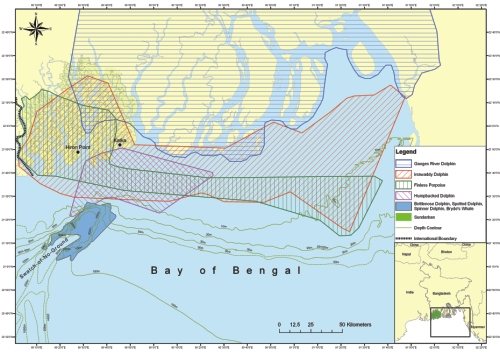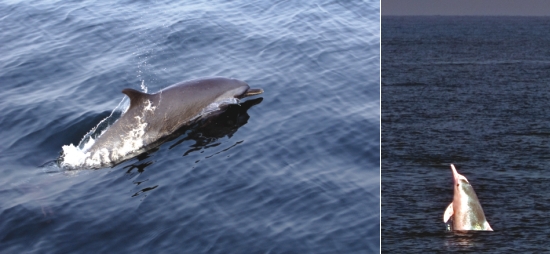|
Wildlife
The Bay of Wonder
A wildlife photographer turned conservationist and his
organisation are fighting for a protected area in the
Sundarbans for Bangladesh's threatened dolphins
Ahmede Hussain

Bottlenose dolphin at the Swatch-of-No-Ground
Rubaiyat Mansur, fondly called Mowgli by his friends and family, was charmed by the magic of the Sundarbans. In fact, in the early and late nineties he was on board different tourist vessels of Guide Tours, which his father owns, as a tour guide and a wildlife photographer. It was on a visit like this that he met Brian Smith, zoologist and Asia coordinator of IUCN Species Survival Commission, who frequents the shores of Bangladesh and was on a trip to find more about the Irrawaddy dolphins. “The dolphin survey, which was coducted in 2002 and went on for 20 days, was for the first time in our history that we have come to know that along with Ganges River dolphin, commonly known as shushuk, Irrawaddy dolphins also exist in the Sundarbans in a large number,” Mowgli says.
After that, he along with the captains of the Guide Tours ships, have done a lot of small researches on their own. In 2004 they trekked the entire coastal belt and 50 kilometres in the bay to find out the varieties of whales, dolphins and porpoises that grace our waters. After seeing the photos that he had taken of the marine life in the coast, Brian told him to start working on the dolphins, telling him that young Bangladeshis like him should come forward to preserve the natural diversity of the country.

Spinner dolphins
There has been no turning back since then. In the winter of 2005 he and his organisation Bangladesh Cetacean Diversity Project (BCDP) started a project on photo-identification of the bottlenose dolphins of the Sundarbans. “We have found that a huge swathe of water, which spans about 40 kilometres near Mongla is a hotspot of bottlenose dolphins. Because these dolphins come in close proximity with fishing trawlers, they bump into accidents; sometimes their fins get cut off by the blades of these vessels,” Mowgli, who has been at sea in the last three seasons, says.
This water, known as the Swatch-of-no-ground is, in fact, a thriving ground for the whales and dolphins for its unique makeup. “Situated on the south of the delta the Swatch-of-no-Ground is a trough-shaped marine valley or underwater canyon. With a flat floor that is 5 to 7 km wide, depths in the trough at the edge shelf are about 1,200m. It has been suggested that the Swatch-of-no-Ground has a seaward

Researchers at work |
continuation for almost 2,000 km down the Bay of Bengal,” an officer in the Bangladesh Navy explains.
 But the menace that this 120-kilometre coastline, including the Swatch, poses for the marine mammals is manifold in nature. At risk is not only the survival of bottlenose, but also around 6000 Irrawaddy dolphins, which live in the estuary and consist the largest population of such dolphins in the world. Even though the fishermen do not target these animals, some get entangled in their nets, meeting painful deaths for these mammals need to breath like humans. “Besides incidental killings,” says Elisabeth Fahrni Mansur of the BCDP, “toxic contamination and the use of gillnet fisheries are rampant in this part of the sea'. Another reason why the government must take urgent measures is that the prey of the cetaceans are depleting fast due to massive catch of fish fingerlings. Elisabeth and the BCDP propose a network of protected areas in the mangrove channel and deep-sea canyon waters where whales and dolphins inhabit in all seasons. But the menace that this 120-kilometre coastline, including the Swatch, poses for the marine mammals is manifold in nature. At risk is not only the survival of bottlenose, but also around 6000 Irrawaddy dolphins, which live in the estuary and consist the largest population of such dolphins in the world. Even though the fishermen do not target these animals, some get entangled in their nets, meeting painful deaths for these mammals need to breath like humans. “Besides incidental killings,” says Elisabeth Fahrni Mansur of the BCDP, “toxic contamination and the use of gillnet fisheries are rampant in this part of the sea'. Another reason why the government must take urgent measures is that the prey of the cetaceans are depleting fast due to massive catch of fish fingerlings. Elisabeth and the BCDP propose a network of protected areas in the mangrove channel and deep-sea canyon waters where whales and dolphins inhabit in all seasons.
Mowgli thinks the protected areas should not exclude the fishermen who go there for their bread and butter, or rather, for their fish and salt. “We want a participatory, sustainable development, which will include all the stakeholders,” he says. His organisation proposes three protected sites for shushuks and Irrawaddy dolphins centring on Katka. Another protected area he proposes for the Swatch, where four species of cetacean population can be found, of them three are dolphins and one is a whale. The first protected area that he proposes is a 12 kilometre channel from Ghagramari Forest Department Patrol Post to the Karamjal Patrol Post through Dhangmari creek on the Passur. The second area will stretch 15 kilometres from Jongra patrol post on the Passur to the confluence of Urubunia creek. The third protected are in the Sundarbans will be 5-kilometeres long, starting from Dudmukhi post to the confluence of the Bhola River.

Distribution of whale and dolphin population
Besides monitoring the killings of dolphins, the government must also provide the fishermen with global positioning systems and depth sounders and train them their usage so that the fishermen can navigate safely. For their turn, the fishermen will safely release live dolphins that get caught up in the nets and collect samples from the dead animals to pass them on to the authorities concerned.

A Group of Bryde's whale at the Swatch-of-No-ground
Creation of a protected area for the whales and dolphins seems a far cry for Mowgli and his team who have continually got the cold shoulder from the government. Apathy remains high. It so happened that many fishermen in the Sundarbans laughed at Mowgli and his crew when he asked them whether they had seen any whale in the water. Their laughter turned into smiles of recognition when he showed them some photos of Bryde's whale. He says, “Suddenly they screamed, 'We have seen it many a time'; imagine if this is the case of the people who live half their lives in water how apathetic the townies will be to the plight of the dolphins?”

To save the threatened life of the marine mammals the BCDP is organising an exhibition titled 'Introducing Whales and Dolphins of Bangladesh', the aim of which is to make people aware of the plight of these animals. “The interactive exhibition aims at introducing Bangladesh's cetacean diversity and the ongoing conservation efforts. Through photographs, film shows, games, and models we hope to create a sense of pride and foster support for the conservation of these unique aquatic animals,” Mowgli says.
Introducing Whales and Dolphins of Bangladesh
Bangladesh Cetacean Diversity Project
Bangladesh Shishu Academy, Dhaka
October 9-12, 2008
Copyright
(R) thedailystar.net 2008 |
